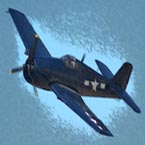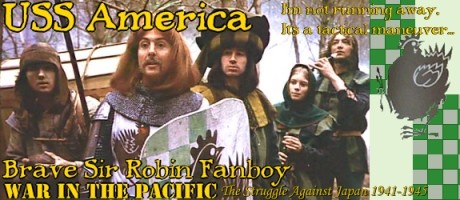VSWG
Posts: 3432
Joined: 5/31/2006
From: Germany
Status: offline

|
1. Calculating Load Cost
Lets start with a simple example.

This artillery LCU has three different devices: two artillery devices (the Howitzers and the Field Guns), and one infantry device (the Support Squads). Every device has a "Load Cost" defined in the editor (use WitPLoad or WitP Tracker to extract the database):
- a 155mm Howitzer has a Load Cost of 30
- a Support Squad has a Load Cost of 20
- a 75mm Field Gun has a Load Cost of 18
Multiplying the number of devices with their load cost gives us the "Raw Load Costs" for these devices: 1080 for all Howitzer devices, 640 for all Support devices, and 216 for all Field Guns. Total: 1936. This is not the amount of cargo capacity you'll need, because this number depends on the type of ships you're going to use. Lets focus on AKs, APs, and LST.
On p. 97 of the manual you'll find the following table:

On an AP, every load cost point of an infantry devices takes up one point of cargo capacity. However, every load cost point of an artillery device needs 3 points of cargo capacity.
AKs can store artillery devices more efficiently: only 2 cargo capacity points are needed for every load cost point. However, a single load cost point of an infantry device wastes 6 (!!!) cargo capacity points on an AK! Very inefficient.
LSTs are great ships: the multiplier for artillery load cost points is 1, the multiplier for infantry load cost points is 2. On top of that, they have an awesome amphibious bonus, but that's a different topic (see p. 99 of the manual).
Note that the multipliers apply on the device level, not unit level!! There is no common multiplier for all devices in an artillery unit, but a common multiplier for all artillery devices in all different unit types (base forces, combat units, CD units, ...).
Now it's rather simply to calculate the total cargo capacity that you need to transport a unit:

The sums for AK, AP and LST are identical with what is displayed in the bottom right corner of the LCU screen above. 
So now you've decided to transport this unit using a large task force of APs. You assemble the TF (one for every LCU, you can combine them when they have completed loading), and - very important - you select "Do not unload", or the TF will start unloading right after it has completed loading. Clicking on "Load troops" or "Load only troops", produces the following screen.

It displays all LCUs and air groups that are attached to unrestricted commands in the base. To the right of these unit, you'll find the same load cost numbers as in the LCU screen.
Don't let the number at the bottom, "Selected Load", confuse you: this is the "Raw Load Cost" of the LCU. This number is correct (see table above), but in most cases useless. It applies only when all ships in your TF can carry all devices in your unit with an efficiency of 1 load cost point per capacity point. For instance, the number would be correct for an all AP TF loading a HQ unit with just support squads. However, in this case the same number will appear in the "Load Cost - AP" column on this screen as well. Just ignore this number.
After the TF has loaded, the "Total Load" number in the TF screen matches, too:

2. Maximizing transport TF efficiency
Since different devices have different multipliers WITHIN a LCU, you can increase the efficiency of your troop transport TFs by mixing AKs and APs. A post by wwengr covers this topic nicely:
quote:
ORIGINAL: wwengr
Basically, it boils down to this. A well composed TF will ideally load squads & vehicles & such onto the ship that is most efficient at carrying each. It will also attempt to load evenly across the TF.
Let's call the points of load capacity that the AK and AP have as Load Capacity Points (CAP). Let's call the points of load cost that each squad, tank, vehicle, or artillery piece costs to load Load Cost (COST). Also note that the column called Infantry really should have been called Troops since it includes all Squads, Engineers, Support, and Aviation Support.
As you read the table each point of COST for that particular type of item = the stated number of CAP. In other words a USA Rifle Squad has a load cost of 10 (COST = 10). An AP has 2000, 4000, or 6000 CAP. An AK has 4500, 7000, or 7200 CAP. Troops loaded on an AP require 1 CAP for every COST. Troops loaded on an AK require 6 CAP for every Cost.
To load 1 USA Rifle Squad on an AP requires COST x 1 = 10 CAP
To load 1 USA Rifle Squad on an AK requires COST x 6 = 60 CAP
This also relates to how fast the troops will load and unload. It takes 6 times longer to unload a rifle squad from an AK than from an AP.
Let use an example and build an ideal TF to load a full strength USA RCT for an invasion using only AP and AK. A USA Infanrty RCT has:
- 121 x USA Rifle Squads (10 COST each = 1,210 COST) (AK requires 7,260 CAP, AP requires 1,210 CAP)
- 9 x USA Engineer Squads (10 COST each = 90 COST) (AK requires 540 CAP, AP requires 90 CAP)
- 18 x 81mm Mortars (4 COST each = 72 COST) (AK requires 144 CAP, AP requires 216 CAP)
- 4 x 4.2in Mortars (4 COST each = 16 COST) (AK requires 32 CAP, AP requires 48 CAP)
- 18 x 37mm AT Guns (6 COST each = 108 COST) (AK requires 216 COST, AP Requires 324 COST)
- 6 x 75mm Pack Howitzer (9 COST each = 54 COST) (AK requires 108 CAP, AP requires 162 CAP)
- 12 x 105mm Howitzers (12 COST each = 144 COST) (AK requires 288 CAP, AP requires 432 CAP)
- 4 x 155mm Howitzers (15 COST each = 60 COST) (AK requires 120 CAP, AP requires 180 CAP)
- 6 Engineers (20 COST each = 120 COST) (AK requires 720 CAP, AP requires 120 CAP)
- 176 Support (20 COST each = 3,520 COST) (AK requires 21,120 CAP, AP requires 3,520 CAP)
Ideally, you would like to load the Rifle Squads, Engineer Squads, Engineers, and Support on AP's and the rest on AK's. There are 4,940 CAP points for AP and 908 points for AK. They will load the items that load the quickest on each and they will load evenly across the TF (up to a point) So consider this, the numbers give you an approximate ratio of 5 AP's to 1 AK. I would then select 5 AP's and 1 AK to load the regiment. for simplicity sake, let's say we have that TF in a size 5 port. A size 5 port will load 1,000 points per ship per day, so if you hit Load Troops, it will load the regiment in a single turn and begin to load supplies.
It will be far less than perfect, but most of the troops will be loaded on AP's and most of the devices will be loaded on the AK.
http://www.matrixgames.com/forums/tm.asp?m=1667651
Another example from the same thread:
quote:
ORIGINAL: VSWG
I just ran some quick tests and I can confirm that an AK or two in an AP TF can reduce the total load needed.
I loaded an EAB at SF onto different TFs. The EAB had 10 Engineer Vehicles, 45 Support Squads and 30 Engineer Squads, all not disrupted.
AP TF: 2100 capacity points
AK TF: 9400 capacity points.
Mixed TF (1 AK, several APs): 2080 capacity points.
Mixed TF, 50 % AKs, 50 % AP: 4150 capacity points.
The mixed TF with 1 AK was the most efficient. I know it's not much of a difference, but keep in mind that I replaced an AP with an AK, so the AP is now free to transport another unit. The loading algorithm moved 6 Engineer Vehicles and 1 Support Squad onto the AK. Not bad, but ideally only the vehicles should have loaded.
The problem with mixed TFs is that you have to be careful not to add too many AKs. If the loading algorithm runs out of vehicle, artillery or tank devices to load onto AKs, it will load infantry squads instead, because it wants to distribute the LCU equally among all ships.
Infantry Squads + AK = BAD!
[Removed: cargo capacity table from the manual, see above.]
You can see that it's no big deal if vehicle, artillery or tank devices make it onto an AP, but Infantry Squads load REALLY INEFFICENTLY onto AKs. This must be avoided. I suggest adding only a single AK for small units with different kinds of device types (not HQ or aviation support units, they have only infantry devices!!). INF LCUs generally have more non-infantry squads, so I think several AKs should be added here, and this will increase the efficiency a lot more than in the above example.
< Message edited by VSWG -- 8/10/2008 6:28:37 PM >
_____________________________
|
 Printable Version
Printable Version













 AE will change the loading routine completely. The basic concept as above will be the same, but there will be a lot more modifiers...
AE will change the loading routine completely. The basic concept as above will be the same, but there will be a lot more modifiers... 



 Have you added this one to the Must Read Threads list yet?
Have you added this one to the Must Read Threads list yet?

 New Messages
New Messages No New Messages
No New Messages Hot Topic w/ New Messages
Hot Topic w/ New Messages Hot Topic w/o New Messages
Hot Topic w/o New Messages Locked w/ New Messages
Locked w/ New Messages Locked w/o New Messages
Locked w/o New Messages Post New Thread
Post New Thread